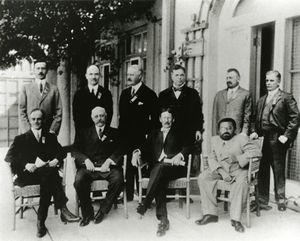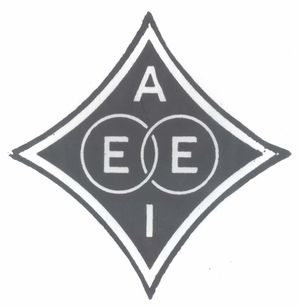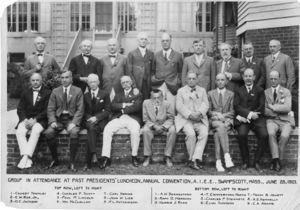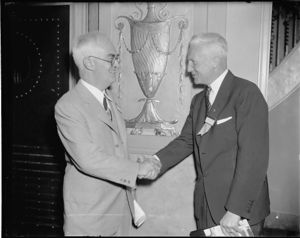List of Presidents of the American Institute of Electrical Engineers (AIEE)
From ETHW
AIEE Presidents, 1884-1963

A group of past presidents at the AIEE Chicago Convention, June 29, 1911. Photo appears on page 1773 of the 50th Anniversary special issue of "Electrical Engineering." Back row (l-r) Gano Dunn, Dugald C. Jackson, Louis A. Ferguson, Schulyer S. Wheeler, John W. Lied, and Bion J. Arnold. Front row (l-r) Francis C. Crocker, T. Commeford Martin, Frank J. Sprague and Charles P. Steinmetz.
- Norvin Green, 1884-1886, became the president of Western Union in 1878. He later was one of the founders of the AIEE in the early 1880s.
- Franklin L. Pope, 1886-1887, one of America’s first practicing electrical engineers. In addition to his inventions and patents, which greatly contributed to the field of electrical engineering, he authored several books in the genres of literature, history, and genealogy.
- T. Commerford Martin, 1887-1888, editor of electrical magazines and an author of various works. He also worked for the U.S. Census Office from 1900-1915, where he wrote reports about electrical industries and utilities.
- Edward Weston, 1888-1889, improved electrical instruments so that they would be more portable and that their measurements would become more accurate. In 1908, his standard cell became the universal standard of electromotive force.
- Elihu Thomson, 1889-1890, his invention of the 3 coil dynamo was the foundation to a successful electric lighting system that he and colleague E. J. Houston produced in 1879 through their company Thomson-Houston Electric Company. This company merged with Edison General Electric Company in 1892 to form General Electric Company.
- William A. Anthony, 1890-1891, professor of physics and mechanics at many U.S. universities. In addition to teaching, he also contributed articles to many electrical engineering magazines, and was an electric engineer consultant in New York City.
- Alexander Graham Bell, 1891-1892, most known for his invention of the telephone in 1876.
- Frank Julian Sprague, 1892-1893, founded the Sprague Electric Railway and Motor Company, which later developed an electric railway system in Richmond, Virginia using electric traction.
- Edwin J. Houston, 1893-1895, collaborated with Elihu Thomson to create a successful electric lighting system. In addition to his inventions, Houston was also a university professor, author, and engineering consultant.
- Louis Duncan, 1895-1897, served as an electrical engineering professor at Johns Hopkins University for 14 years. After retiring from his career in academia, Duncan was an engineering consultant for many traction, utility, and railway companies.
- Francis B. Crocker, 1897-1898, pioneered the design for commercially successful motors. Crocker also supported the national and international standardization of electrical equipment.
- Arthur E. Kennelly, 1898-1900, co-discovered the Heaviside-Kennelly layer in the ionosphere with Oliver Heaviside in 1901, which contributed to the study of radio waves.
- Carl Hering, 1900-1901, an electrical engineer who researched storage batteries, designed and improved the electric furnace, and made discoveries regarding electromagnetic force. Hering also published works about mechanical and electrical engineering.
- Charles P. Steinmetz, 1901-1902, worked on inventions for electric motors, generators, and street cars. In addition to his research, he was an electrophysics professor at Union University.
- Charles F. Scott, 1902-1903, created a new method for phase transformation called the “Scott Connection.” In 1911, Scott became an electrical engineering professor at Yale University, and he served as the head of the Electrical Engineering Program at the university.
- Bion J. Arnold, 1903-1904, pioneered street railways in numerous cities across the United States, and he helped to bring electricity to New York’s Grand Central Station. In addition to his work on railways, Arnold also invented a magnetic clutch and improved storage batteries.
- John W. Lieb, 1904-1905, experimented with the Brush arc light system in the fall of 1877, which led him to work at the Brush Electric Company and later the Edison Electric Company. Lieb also worked in Italy, where he directed the completion of Milan’s first electric trolley line in 1893.
- Schuyler Skaats Wheeler, 1905-1906, worked with Francis B. Crocker on small electric motors. Wheeler invented the electric fire engine, the electric elevator, and the electric fan among other inventions.
- Samuel Sheldon, 1906-1907, a physics and electrical engineering professor at Polytechnic Institute in Brooklyn, New York. While at the university, he expanded their laboratories to include physical, mechanical, and electrical engineering research.
- Henry G. Stott, 1907-1908, the assistant engineer of Buffalo, New York’s underground cable and conduit system. In 1901, he became the supervisor for the Interborough Rapid Transit System in New York City.
- Louis A. Ferguson, 1908-1909, recommended the 3 phase a-c system for substations, and has made important contributions to the development of low voltage distribution.
- Lewis B. Stillwell, 1909-1910, the director of the Niagara Falls Power Company in 1897, and he became the director of the Rapid Transit Subway Company of New York City in 1900. In addition to his work as an engineer and a consultant, Stillwell was also an advocate for energy conservation.
- Dugald C. Jackson, 1910-1911, supervised the design and construction of several railway and power plants when he worked as an engineer at Sprague Electric Railway and Motor Company and later as an engineer for Edison General Electric Company.
- Gano Dunn, 1911-1912, became president of the J. G. White Engineering Corporation in 1913. Included among the company’s projects were the United States Naval Oil Base at Pearl Harbor, 13 transoceanic radio stations, and the first long-distance natural gas pipeline in California.
- Ralph D. Mershon, 1912-1913, an engineer whose most notable contribution to engineering is his work with high voltage transmission. Mershon also invented a 6-phase rotary converter, the compounded rotary converter, and a compensating voltmeter among other inventions.
- Cyprien O. Mailloux, 1913-1914, the editor of Electric World, and supported the standardization of technical terms.
- Paul M. Lincoln, 1914-1915, invented the synchroscope. He also worked as an electrical engineer, and taught electrical engineering at Cornell University.
- John J. Carty, 1915-1916, designed the “bridging bell”, which allowed extended telephone use to rural areas of the United States. Carty also announced AT & T’s intention to complete a transcontinental telephone line.
- Harold W. Buck, 1916-1917, supervised the experimental work that led to the development of the oil circuit breaker and other high voltage devices while working at General Electric Company. He also worked as the chief electrical engineer at the Niagara Falls Power Company, where he worked on the distribution of power across the U.S.-Canada border.
- Edwin W. Rice, Jr., 1917-1918, is considered one of the three fathers of General Electric. Rice filed over 100 patents for his inventions, which include oil switches of high capacity, arc lamps, and synchronous converters among other creations.
- Comfort A. Adams, 1918-1919, worked as an electrical engineering professor at Harvard University. His interest in welding technology led him to design the first alternating-current transformer, which allowed him to maintain contact with “real world” engineering work.
- Calvert Townley, 1919-1920, an electrical engineer who worked on the installation and equipment maintenance of transit systems in the Northeast. Two of his most notable projects were working with electrical equipment in Boston’s South Terminal and the electrification of railroad lines leaving New York City.
- Arthur W. Berresford, 1920-1921, worked as an engineer for the Brooklyn City Railroad Company where he overhauled motors and assisted with trolley line construction. He later worked for the Riker Electric Company, which manufactured rheostats and electric controlling devices.
- William McClellan, 1921-1922, supervised the layout and installation of a high-voltage substation and the car equipment for the Erie Railroad. He also worked at University of Pennsylvania as a university professor and dean.
- Frank B. Jewett, 1922-1923, worked as an engineer for AT&T, where his work demonstrated transatlantic radio telephony using a vacuum-tube transmitter.
- Harris J. Ryan, 1923-1924, a university professor at Cornell University and later Stanford University, where he researched high voltage phenomena.
- Farley Osgood, 1924-1925, a traveling engineer who made inspections and installations for the New England Telephone and Telegraph Company. He also served as vice president and general manager of Public Service Electric and Gas Company (PSE&G).
- Michael I. Pupin, 1925-1926, taught mathematical physics at Columbia University. He also studied wave propagation, and applied his findings to long distance telephony experiments and research.
- Cummings C. Chesney, 1926-1927, a member of the Stanley Electric Manufacturing Company, which built the first revolving field type of alternator used in the United States.
- Bancroft Gherardi, 1927-1928, improved telephone transmission circuits by demonstrating that telephone transmission followed the same laws of attenuation as lower frequency telegraph.
- Rudolph F. Schuchardt, 1928-1929, the chief electrical engineer at Chicago Edison Company.
- Harold B. Smith, 1929-1930, one of the pioneers in developing high-voltage power transmission systems and equipment.
- William S. Lee, 1930-1931, president of W.S. Lee Engineering Corporation of New York and Charlotte. He also worked with James B. Duke in developing hydroelectric resources in the southern United States.
- Charles E. Skinner, 1931-1932, in charge of the insulation design and magnetic testing departments at Westinghouse Company, and he later organized a research division for the company’s engineering department. Skinner was also active in the field of international standardization.
- Harry P. Charlesworth, 1932-1933, vice president of Bell Telephone Laboratories, Inc., where he directed the development and research of telephone communication.
- John B. Whitehead, 1933-1934, a professor Johns Hopkins University. He also was commissioned as a major in the Corps of Engineers in the U.S. Army during World War I, and he served as an adviser to the Navy during World War II.
- J. Allen Johnson, 1934-1935, served as the chief electrical engineer of the Buffalo Niagara Eastern Power Corporation.
- Edward B. Meyer, 1935-1936, was the chief electrical engineer of the Public Service Corporation of New Jersey.
- Alexander M. MacCutcheon, 1936-1937, the chief engineer for the Reliance Electric and Engineering Company.
- William H. Harrison, 1937-1938, member of the engineering staff at the American Telephone and Telegraph Company. He was later the plant engineer at the Bell Telephone System central office.
- John Castlereagh Parker, 1938-1939, was part responsible for the reconstruction of the Brooklyn Edison Company’s electrical system. He also served as the vice president in charge of engineering of the Hudson Avenue Station in Brooklyn, which would become the world’s largest steam-electric generating station.
- F. Malcolm Farmer, 1939-1940, was a member of several standardization organizations, and he was also a published author.
- Royal W. Sorensen, 1940-1941, was a leader in the field of high-voltage, long distance electrical transmission, and he invented the vacuum switch for high-current electrical circuit. Sorensen was also worked as an electrical engineering professor at Throop/Caltech.
- David C. Prince, 1941-1942, managed the commercial engineering department at General Electric Company.
- Harold S. Osborne, 1942-1943, worked on wireless telephony. He is also a former mayor of Montclair, New Jersey.
- Nevin E. Funk, 1943-1944, was vice president in charge of engineering at the Philadelphia Electric Company.
- Charles A. Powel, 1944-1945, was the assistant to the vice president of engineering for Westinghouse in East Pittsburgh, Pennsylvania.
- William E. Wickenden, 1945-1946, was elected president of Case School of Applied Science at Case Western Reserve University in 1929.
- J. Elmer Housley, 1946-1947, was in charge of engineering at the Aluminum Company of America, and supervised the operation and maintenance of the company’s hydro-electric power system.
- Blake D. Hull, 1947-1948, became chief engineer for Southwestern Bell Telephone Company in 1936.
- Everett S. Lee, 1948-1949, became the Consulting Laboratory Engineer for General Electric in 1945, and he was the editor for the General Electric Review from 1951 to 1958.
- James F. Fairman, 1949-1950, elected vice president on Consolidated Edison Company of New York, Inc., and supervised electric and gas production and operation.
- Titus G. LeClair, 1950-1951, invented relay schemes, switching schemes, automatic printing meters, and special conductors.
- Fred O. McMillan, 1951-1952, was an engineering professor at many U.S. universities, and he also was a consulting engineer for a number of public utility companies.
- Donald A. Quarles, 1952-1953, was vice president of Bell Telephone Laboratories. In 1954, President Eisenhower appointed him as a member of the National Advisory Committee for Aeronautics.
- Elgin B. Robertson, 1953-1954, was chief electrical engineer, and later became midwest manager for The Railway and Industrial Engine Company.
- Alexander C. Monteith, 1954-1955, was vice president and chairman of the Westinghouse Educational Foundation.
- Morris D. Hooven, 1955-1956, served on the inter-utilities committee at the Public Service Electric Company (PSE&G), which established the Pennsylvania-New Jersey 220 kv Interconnection. He also worked on other committees that developed load studies, operating communications, river basin studies, and plant designs.
- Mervin S. Coover, 1956-1957, worked at the University of Colorado as both a professor and a dean. He also served as the assistant regional coordinator of the Engineering Science and Management Defense Training Program.
- Walter J. Barrett, 1957-1958, worked in the Operation and Engineering Department at the American Telephone and Telegraph Company in New York City. He later was employed in the Engineering Department at the New Jersey Bell Telephone Company.
- L. F. Hickernell, 1958-1959, became vice president of engineering for the Anaconda Wire & Cable Company in 1957.
- James H. Foote, 1959-1960, was chief engineer for Commonwealth Associates, Inc., and he also served as director of Atomic Power Development Associates, Inc.
- Clarence H. Linder, 1960-1961, worked at General Electric from 1924 to 1963. He served as GE's Vice President of Engineering from 1953 to 1959.
- Warren J. Chase, 1961-1962, served as chief engineer and later was appointed vice president of Ohio Bell Telephone Company.
- B. Richard Teare, Jr., 1962-1963, was an electrical engineering professor at Yale University and later at the Carnegie Institute of Technology.
Further Reading
Also see Presidents of the IRE and Presidents of the IEEE.


